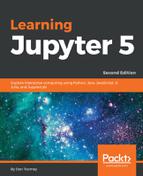Book Description
Create and share livecode, equations, visualizations, and explanatory text, in both a single document and a web browser with Jupyter
Key Features
- Learn how to use Jupyter 5.x features such as cell tagging and attractive table styles
- Leverage big data tools and datasets with different Python packages
- Explore multiple-user Jupyter Notebook servers
Book Description
The Jupyter Notebook allows you to create and share documents that contain live code, equations, visualizations, and explanatory text. The Jupyter Notebook system is extensively used in domains such as data cleaning and transformation, numerical simulation, statistical modeling, and machine learning. Learning Jupyter 5 will help you get to grips with interactive computing using real-world examples.
The book starts with a detailed overview of the Jupyter Notebook system and its installation in different environments. Next, you will learn to integrate the Jupyter system with different programming languages such as R, Python, Java, JavaScript, and Julia, and explore various versions and packages that are compatible with the Notebook system. Moving ahead, you will master interactive widgets and namespaces and work with Jupyter in a multi-user mode.
By the end of this book, you will have used Jupyter with a big dataset and be able to apply all the functionalities you've explored throughout the book. You will also have learned all about the Jupyter Notebook and be able to start performing data transformation, numerical simulation, and data visualization.
What you will learn
- Install and run the Jupyter Notebook system on your machine
- Implement programming languages such as R, Python, Julia, and JavaScript with the Jupyter Notebook
- Use interactive widgets to manipulate and visualize data in real time
- Start sharing your Notebook with colleagues
- Invite your colleagues to work with you on the same Notebook
- Organize your Notebook using Jupyter namespaces
- Access big data in Jupyter for dealing with large datasets using Spark
Who this book is for
Learning Jupyter 5 is for developers, data scientists, machine learning users, and anyone working on data analysis or data science projects across different teams. Data science professionals will also find this book useful for performing technical and scientific computing collaboratively.
Downloading the example code for this book You can download the example code files for all Packt books you have purchased from your account at http://www.PacktPub.com. If you purchased this book elsewhere, you can visit http://www.PacktPub.com/support and register to have the files e-mailed directly to you.
